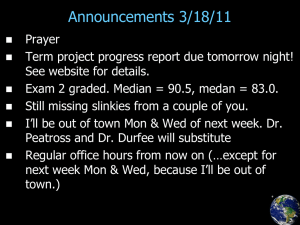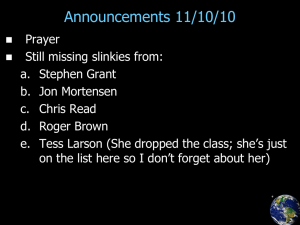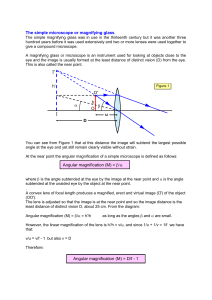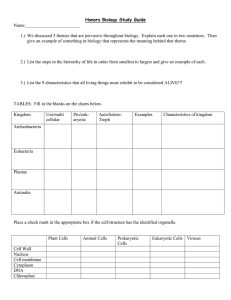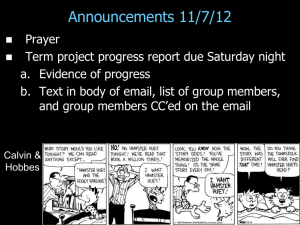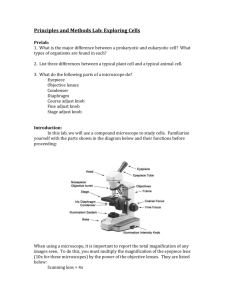lecture 31 - magnifier, telescope
advertisement
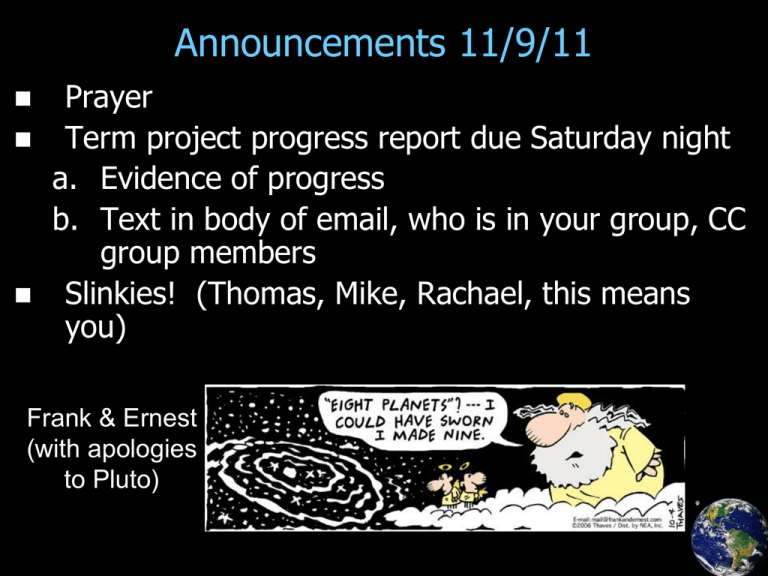
Announcements 11/9/11 Prayer Term project progress report due Saturday night a. Evidence of progress b. Text in body of email, who is in your group, CC group members Slinkies! (Thomas, Mike, Rachael, this means you) Frank & Ernest (with apologies to Pluto) Thought question Which will look bigger* to you, a 1 m tall object that’s 5 meters away from you, or a 10 m tall image that’s 50 meters away from you? a. 1 m tall object b. 10 m tall image c. same * In the sense that it takes up more of your field of view “angular size” Worked Problem What is the angular size of a 0.1 m tall object that’s 5 meters away from you? Two methods! Thought Question Which method should you use? a. Method A b. Method B Quick writing You are looking at an ant, h = 1 mm. What is the maximum viewing angle you can use to look at the ant, without any lenses? “Colton picture” r q q (in radians) = (section of arc)/r Reading Quiz Which of the following is NOT true of angular magnification? a. It is more useful than the absolute magnification when discussing telescopes b. It is more useful than the abs. magnification when discussing magnifying glasses c. It is given by the equation m = -q/p d. It is likely to show up on an exam. m = q/q0 … where q0 = “the best you can do without magnification” Magnifying Glass The setup: f = 10 cm Where would you like the image to be? Let’s pick q = -50 cm. (q would generally be given in problem.) Answers: What is m? (m = q/q0) q = 6h/50 rad a. What is q? q0 = h/25 rad b. What is q0? m=3 Note: using formulas from book… mmax = 3.5 (for q = 25 cm) mmin = 2.5 (for q = infinity) Aside: What will the ant see? f = 10 cm h 8.33 cm If p = 1 cm: q = (1/10 – 1/1)-1 = -1.11 M = -q/p = 1.11 1.11h 9.44 1.10 h 9.33 m = q/q0 = If p = 9.5 cm: q = (1/10 – 1/9.5)-1 = -190 (fixed from in- M = -q/p = 190/9.5 = 20 class values) 20h (190 8.33) m = q/q0 = h (9.5 8.33) 1.80 p If p = 20 cm: q =+20 (ant can’t see you!) Quick writing You are looking at the planet Mars, “h” (diameter, really) = 3.4 106 m. The planet, as you are looking at it, is 2.5 1011 m away (this changes from month to month based on the relative positions of Mars and Earth). What is the maximum viewing angle you can use to look at Mars, without any lenses? “Colton picture” r q q (in radians) = (section of arc)/r Telescope The setup: Given details of setup, what is m? (m = q/q0) a. What is q0? b. What is q? These focal spots should essentially overlap (not shown properly in this figure) “Colton picture” for q r Answers: q0 = h/r q = foh/(rfe) m = fo/fe fo Because Mars is so far away, image is formed at the focal spot (essentially) Height of image = hfo/r fe (from M = -q/p) triangle: q (rad) = (intermed. height)/fe q image If intermediate image were formed exactly at the focal point of the eyepiece, final image would be at . As it is, it will just be very far away. Regardless of how far away it is, though, the angle is given by the blue ray. Reflecting Telescope A “Newtonian Reflector” eyepiece lens Incoming Light Curved Mirror Mirror http://lcogt.net/en/book/reflecting-telescopes Compound Microscope I really dislike the eqn: “overall magnification” = Mobjective meyepiece because it mixes absolute magnification with angular magnification (but apparently everyone does it that way) Not on reading assignment, not on HW, not on exam, not especially interesting… let’s not bother with. Onward! http://en.wikipedia.org/wiki/Microscope Chapter 37! Interference effects a. I.e. now returning to wave nature of light, instead of the ray approximation Two mathematical facts we will use: e e cos x 2 ix ix e e sin x 2i ix ix Interference... A single source Next few slides: credit Dr. Durfee Interference... Two sources
